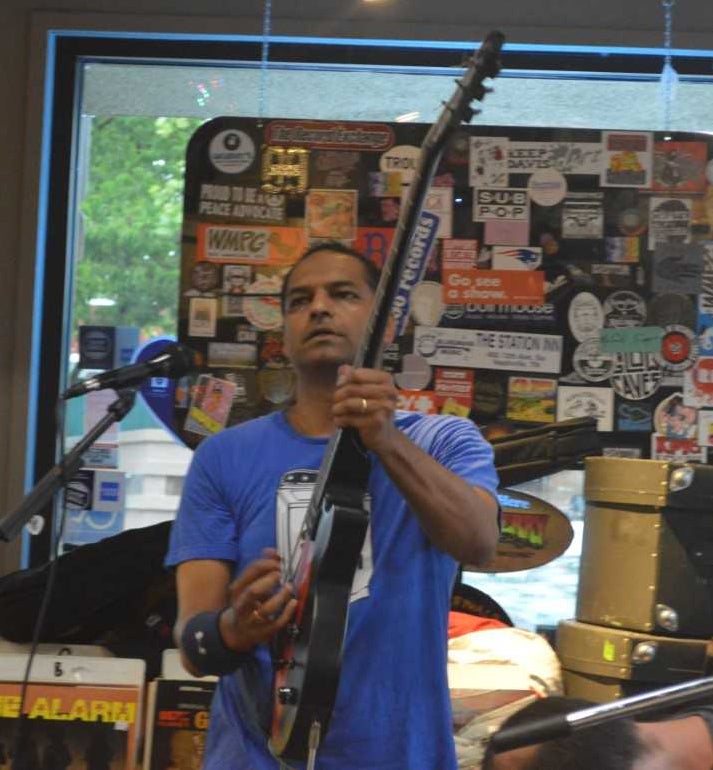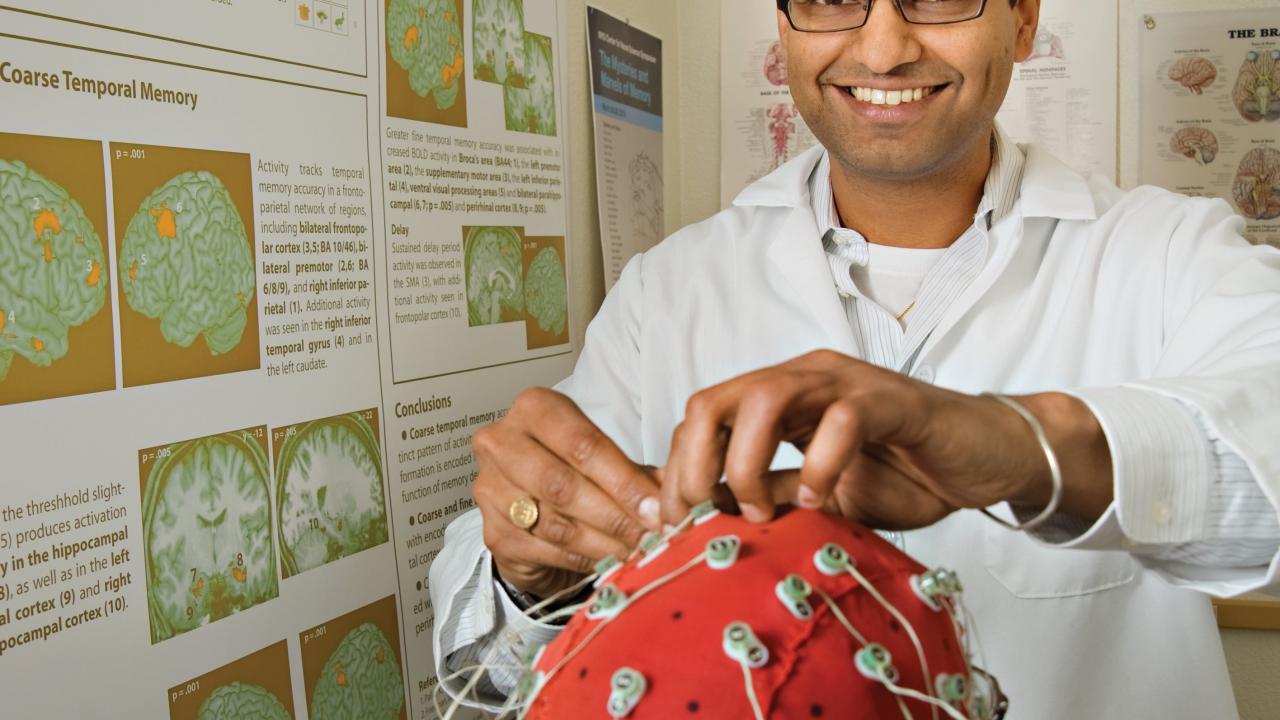Greg Watry, College of Biological Sciences, contributed this piece.
Inspired by a love of music, professor explores brain processes that govern motivation and curiosity
An audio clip from the Apollo 11 launch plays amid static. “Ignition sequence start,” a voice says. “Six, five, four, three…” As the countdown continues, the feedback swells in the background, as if an amplifier’s volume knob is slowly being turned up. “All engines running,” the voice says. “Liftoff.”
Then, the electric guitar hits. Distorted and heavy, the driving riff repeats and is joined by a twangy counterpart and pulsing drums. A cosmic surfer might listen to this song—“Neutron Star” from the Lost Moon EP by the band Here Knows When—while cruising the galaxy.
The tune’s source — UC Davis Aggies.
“It’s mindboggling how many musicians there are in science,” said Charan Ranganath, a guitarist and vocalist for Here Knows When and a professor at the Center for Neuroscience.
“People who are into music like me will just go through phases where we’ll devour music. Kind of like you’d do with papers in a field you’re really interested in.”
Here Knows When comprises a trio of UC Davis researchers and a UC Davis alum, including Jeff Sherman, Danielle Stolzenberg, Daniel Cordova and Ranganath. Formed roughly three years ago, the band throws elements of punk and indie rock into a blender to create a dreamy yet rugged sound.
Audio clip: "Neutron Star," by Here Knows When, a band made up of Aggie researchers and an alum.
Ranganath’s journeys in science and music unfolded on parallel and different tracks, but there are similarities to how he approaches the two. For Ranganath, a cognitive neuroscientist studying memory, both his research and his music are expressions of curiosity, a concept that’s also becoming a focus of his lab.
Origins of musical and scientific exploration
Ranganath started playing music in junior high school when he picked up the trumpet, but a personal connection didn’t form until high school, when metal and punk caught his attention. He picked up the guitar, and by the time he was an undergraduate at UC Berkeley, he was jamming with relatives and friends, eventually forming a grunge band called Plug-in Drug. They’d play venues like 924 Gilman in Berkeley, where bands such as Primus and Green Day cut their teeth.
Initially an electrical engineering major at UC Berkeley, he switched paths and became hooked on psychology after taking a neuropsychology class, where he learned about how different brain disorders affect cognition.
“I think what really got me was working in labs and kind of the idea that science isn’t a bunch of stuff that you memorize,” he said. “It’s a process of problem-solving and trying things out, and people don’t necessarily tell you what to do. You sort of define the problem and how you solve it.”
Following graduation, Ranganath continued his education at Northwestern University, where he studied clinical psychology. Eventually his research focus shifted from studying electrical activity patterns in the brain linked to depression to electrical activity patterns linked to memory.
Like he did in Berkeley, Ranganath explored the local music scene in nearby Chicago. He started listening to bands like Sonic Youth, finding himself drawn to songs with unpredictable melodies.
“They would put together all these alternate tunings that made everything sound like they weren’t normal chords,” he said. “It kind of empowered my own songwriting.”

Ranganath brought that sensibility to his current band at the time, The Great Brain. While the band released an album, some vinyl tracks and a song on the soundtrack for the horror film “Henry II: Mask of Sanity,” they broke up right around the time Ranganath wrapped up his doctoral program and clinical psychology training.
He found a postdoctoral position in neuroscientist Mark D’Esposito’s laboratory at the University of Pennsylvania, where he performed functional magnetic resonance imaging research. In a circuitous turn of events, the lab eventually moved to UC Berkeley and with it Ranganath.
Shortly afterward, he applied for a position at the UC Davis Center for Neuroscience.
A UC Davis band is born
Ranganath joined the UC Davis faculty in 2002. He played a key role in shaping cognitive neuroscience research at the university, and over time, music faded from his focus.
“For a long time after my band broke up in grad school, I was convinced I would never play in a band again,” he said.
Then, someone from the past returned to Ranganath’s life.
Ranganath first met Professor Jeff Sherman, Department of Psychology, while attending Northwestern University, but unknowingly, their paths had crossed before. Years earlier, at UC Berkeley, one of Ranganath’s bands had opened for Sherman’s band, Cinderblock. In 2005, Sherman joined UC Davis’ psychology faculty, and eventually, he and Ranganath started jamming. Assistant Professor Danielle Stolzenberg—another member of the Department of Psychology with a fondness for music—rounded out the initial trio that became Here Knows When.
Science, music, expressing curiosity
While Ranganath tries to keep his neuroscience research separate from his music, the two sometimes bleed together.
“One of the things that we’ve been researching is this idea of curiosity and how does curiosity affect memory,” said Ranganath.
Often in memory experiments, Ranganath will tell participants he wants them to learn a task or memorize something specific. While that might mimic how we learn under direction, it doesn’t account for natural curiosity. After all, Ranganath didn’t delve into punk music and psychology because someone told him to, he got into them because he was curious and felt motivated to learn more about them.
“That motivational drive that I have to seek out that information, it’s actually—I mean, I don’t want to be over simplistic—but it’s associated with this neurotransmitter dopamine, which people often talk about as the pleasure chemical,” said Ranganath. “But it’s not really about pleasure, it’s about energizing you to get rewards.”
From an evolutionary perspective, according to Ranganath, this type of motivation may have played a role in ancient human exploration. Today, Ranganath and colleagues study this neurobiological process in the lab.
“We found that when we asked people questions that triggered that curiosity, you get a little spike in activity in the brain areas the produce dopamine and you also get an enhancement of activity in the hippocampus, which is related to learning information you’re curious about,” he said.
For Ranganath, this neural activity might be activated when he’s noodling on his electric guitar or designing a new experiment.
“Things just come out, and you go with it and you see where it takes you,” said Ranganath. “It’s about finding the knowledge gaps and finding the urge to keep moving forward.”
